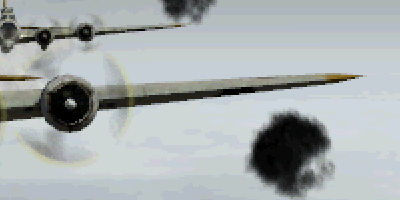Image Quality Tests
When it comes to
gaming, frames per second isn't the only thing on our minds. Just like you, we
demand that the image quality be excellent as well. We're going to be comparing
the Asus Radeon A9600XT's image quality to the Albatron GeForceFX 5600 Ultra,
one of its mainstream competitors. You'll be able to see for yourself how the
cards handle 4x Antialaising, 8x Anisotropic filtering and with both AA and AF
enabled.
| Click on each
image to see the full size image quality comparisons. |
|

|

|
| Radeon A9600XT - 4x AA vs. FX
5600 Ultra - 4x AA |
|

|

|
|
Radeon A9600XT - 8x AF vs. FX
5600 Ultra - 8x AF |
|

|

|
| Radeon A9600XT - 4x AA, 8x AF vs.
FX 5600 Ultra - 4xAA, 8x AF |
Anti aliasing of the
Radeon A9600XT is clearly superior and I've blown up a section from the wing in
3DMark03.


2x Zoom Asus Radeon 9600XT top, Albatron GeForceFX 5600
Ultra below
The Radeon A9600XT's
image is much smoother than the FX 5600 Ultra. Anisotropic filtering with both
videocards was very good, but I think it's too close to call a
clear in this case.
So what's the difference
between the 9600 Pro and XT?
The Radeon A9600XT is essentially a 9600 Pro with an
'overclocked' core. If you remember with our Gigabyte Radeon 9600 Pro
, it was clocked at 400 MHz core, 300 MHz memory, and
the highest we could overclock it was 490 MHz.
Thanks to
improved manufacturing yields the Asus Radeon A9600XT's core is now clocked
at 500 MHz by default. Memory stays the
same at 300 MHz, and the Asus A9600XT uses the same Samsung 2.8ns BGA DRAM that's
found on the 9700 Pro/9800 Pro line of videocards.
Overclocking &
Asus:
As always, we started to overclock the Asus A9600XT core first but we didn't really know
what to expect from it. Going up slowly 5 MHz at a time we easily passed the
530 MHz and 540 MHz marks. Amazingly with stock cooling we were able to
hit the 553 MHz mark, but anything higher and the core would start to artifact while
running through the benchmarks.
With the same 2.8ns Samsung memory that's found on the higher
end Radeon videocards we had some high hopes in terms of overclocking. Unfortunately
they didn't seem to be up to the task as the highest we could push the
memory was 341 MHz. Like the core, anything higher and it would start to cause
artifacts.
Unlike some nVIDIA videocards, we were able to run both the core and memory at their
maximum overclocks without any problems. Now, let's check out those benchmarks!
